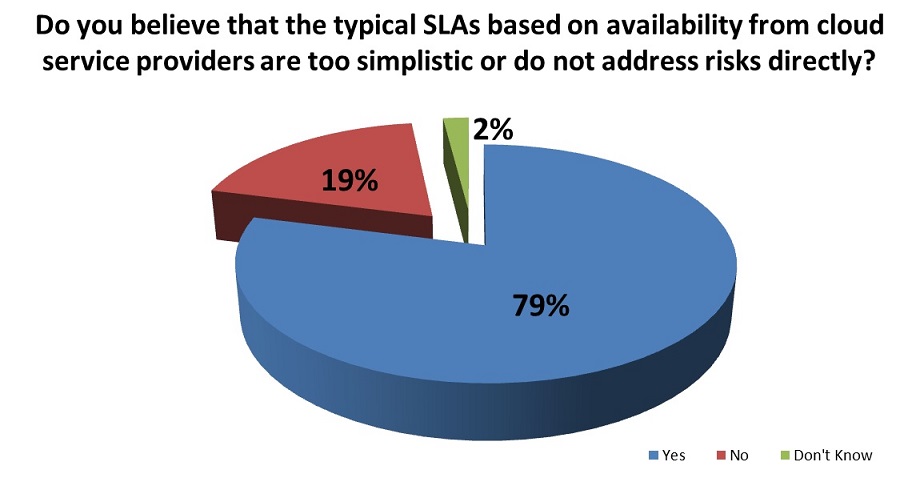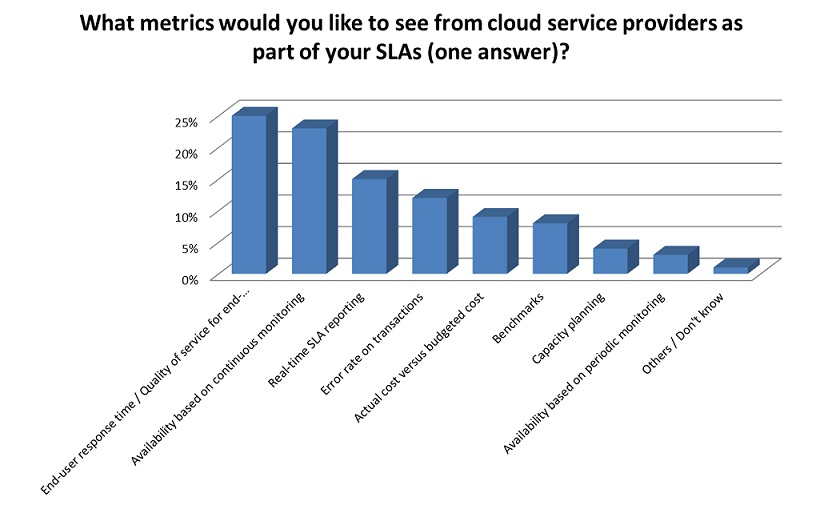
Imagine a well-regarded car dealership trying to sell you a car with a warranty that only covers malfunctions associated with the warning lights you can see on the dashboard – while other issues remain unseen and will not be part of the protection you receive as a buyer. Seems reasonable? No. And that’s exactly what many businesses are saying about the service-level agreements (SLAs) they are getting from cloud providers today.
A recent study with 740 senior IT professionals conducted by independent research and consulting firm Research In Action revealed that the vast majority of CIOs are dissatisfied with their cloud SLAs, feeling they are too simplistic, provide poor visibility, and don’t account for true business risks. This comes to light as APM (Application Performance Management) is increasingly regarded as a crucial tool for empowering businesses to have deep, 24x7 visibility into the performance of their applications across the entire network infrastructure from the server to each and every end-user click, and back.

A business’ bottom line depends on meeting and exceeding expectations for every single customer, 24x7. So, entrusting mission-critical business applications to a cloud provider requires them to deliver total visibility and accountability in order to earn trust. The core problem however, is that a typical cloud SLA is little more than an availability guarantee, focused primarily on specifications rather than service.
Entrusting mission-critical business applications that drive revenue and critical business processes require ultimate trust and accountability in a cloud provider. Metrics like simple uptime do not capture well-known issues such as "noisy neighbors", which can be detrimental to traditional enterprise apps that were not designed to scale and fail horizontally. APM is no longer optional; and as customers bet on the cloud, they must demand granular SLA assurances around performance and rapid problem resolution.
Many survey respondents feel these SLAs are generally not built around the provider giving their customers the promise of visibility or a consistently strong end-user experience. So for an organization counting on cloud performance for the success of mission-critical business process, getting nothing more from their cloud provider than vanity metrics is understandably frustrating.

Predictably, 79% of those surveyed believe typical SLAs are far too basic and fail to address the dangers of moving to and managing applications in the cloud, while 63% of respondents indicated there is a need for more meaningful SLA metrics geared towards ensuring the continuous delivery of a high quality end-user experience. But it gets worse: Nearly three quarters (73%) of businesses believe their cloud providers could be hiding problems, either at an infrastructure or platform-level, that have an impact on application performance. And perhaps most surprisingly, 60% of respondents expressed further anxiety that other, co-located tenants (aka noisy neighbors) consuming difficult to partition resources could impact their own workload performance.
From a business perspective, it’s not enough for an application to simply function. It has to perform well no matter what demand surges or market changes throw at it. Performance is everything, and if an application is not delivering, then businesses need to know that, and understand the reason immediately.
A cloud provider giving you an SLA that provides little more than assurance that “the cloud will be working nearly all the time” and making no mention of meaningful detailed metrics (“will my customers have a reliably great experience, and their needs be fulfilled by the applications they rely upon in my site?”) is under-delivering at best. It’s like a major airline’s pilot announcing proudly “we’re 99.5% sure the plane will get there eventually.” Is anyone getting on that plane? Of course not, so why would you stake your business on an SLA with a similar promise?
It’s no surprise that 75% of IT professionals fear that the loss of control could prevent them from fully optimizing their applications and reduce their return on investment from the cloud. Their fears are well founded. Performance drives ROI and their cloud providers are doing nothing to guarantee performance.
Moreover, 62% of businesses claim that they find it harder to troubleshoot problems in the cloud, and if you can’t troubleshoot, how exactly are you supposed to optimize end-user experience? After all, knowing you have a problem is the first step towards solving it.
According to the survey, executives in the IT world are dissatisfied with their cloud SLAs, and those who aren’t probably should be, because a typical SLA guarantees very little in reality. As a business, you want an application that will consistently perform above and beyond the expectations of your customers. But if all you get out of your cloud provider’s SLA is a promise that basic functionality will happen nearly all of the time, without addressing crucial specifics and caveats that directly impact your business success – it’s just not enough.
What’s the bottom line? Visibility and control (such as that provided by APM) is no longer optional; accordingly, as customers move to the cloud they must demand granular SLA assurances around performance and rapid problem resolution.
Michael Masterson is Director of Cloud Strategy, Compuware APM.
